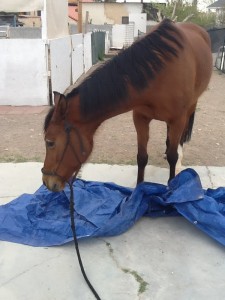 If you’re a horse person, you know horses are usually terrified of things that move around, make crinkly noises, and are strangely colored. So, this makes tarps a great thing to play with to help horses get used to weird things.
If you’re a horse person, you know horses are usually terrified of things that move around, make crinkly noises, and are strangely colored. So, this makes tarps a great thing to play with to help horses get used to weird things.
Teaching a Horse to Walk on a Tarp
Your clicker is loaded, right? So, now you can bring out the tarp.
My horse Zahra had tarp walking experience, but it had been a few years. And back then I never took it so far as I have now.
But let me start from the beginning.
Steps: (In Bombroofing, always take it slowly!! The steps below might happen over a week or two!)
- On a day that’s not windy, pull the tarp out so that it’s tightly folded and in your hand. Let your horse sniff it and click for curiosity.

- Unfold it a wee bit and let your horse explore it some more with her nose. Click. Treat.
- Make some crinkly noises with it and click treat if your horse doesn’t try to run away.
- Pet your horse with the folded up tarp.
- Unfold it a bit more and let the horse walk near it. You might want to weight the edges down with some rocks.
- Unfold it flat and weight it down. Even if there is no breeze, you don’t want the horse to panic if they step on it and it moves too much.
- Encourage ANY movement towards the tarp with a click and a treat. Don’t expect your horse to just walk on it. Click for sniffing it. Click for the horse even looking like she wants to move forward.
- Shift into clicking only forward movement. It still doesn’t have to be ON the tarp yet.
- Click for one foot on.
- Two feet.
- Four feet was surprisingly much harder for my girl to master.
- Bunch up the tarp so that it looks like the photos in this blog entry and encourage your horse to walk on this.
- Do it all again on a windy day! 🙂